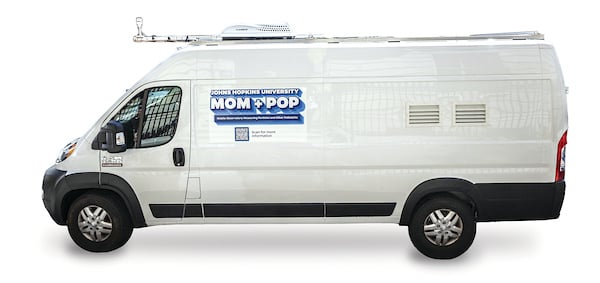
Peter DeCarlo steps back and watches as a colleague dressed in shorts and red, white, and blue sneakers climbs the front of a large white Dodge Ram 3500 ProMaster van. They have parked outside a coffee shop in Baltimore County, Maryland, because their GPS unit is not behaving. DeCarlo is an environmental engineer at the Whiting School, and the van is an instrumentcrammed mobile laboratory called MOM+POP— Mobile Observatory Measuring Particles and Other Pollutants. Atop the van’s roof is a long, horizontal tube. Benjamin Nault, the man now standing on the sloping hood, detaches from it a conical white component involved with location, wind direction, and temperature readings. Then he demonstrates that sometimes the only way to get optimal performance out of some very expensive lab equipment is to remove a piece and blow into it.
We climb back into the van and find that something—Nault’s respiration, jiggling a few cables, divine intervention, who knows?—has restored the GPS to proper function. We pull back out onto the road and drive toward a natural gas pipeline and pumping station near a park called Oregon Ridge. DeCarlo is curious to measure how much, if any, methane might be escaping into the atmosphere.
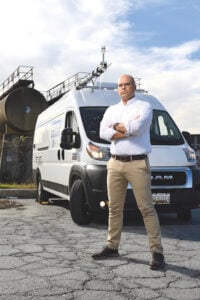 He is an associate professor in the Whiting School’s Department of Environmental Health and Engineering. For 20 years, he has used advanced instrumentation in airplanes, vans, and, on occasion, a backpack to sample and analyze the air, looking for substances that impact the environment and climate and do not belong in human lungs.
He is an associate professor in the Whiting School’s Department of Environmental Health and Engineering. For 20 years, he has used advanced instrumentation in airplanes, vans, and, on occasion, a backpack to sample and analyze the air, looking for substances that impact the environment and climate and do not belong in human lungs.
After securing funding from Bloomberg Philanthropies, he collaborated with Aerodyne Research, a private company, to build MOM+POP and begin making detailed air pollution measurements. His team took delivery of the van in late 2023 and has been road-testing it in New York, Delaware, and Maryland before they head south to the Gulf states later this year or early next year for a project funded by the Bloomberg Philanthropies’ Beyond Petrochemicals initiative.
“There’s a getting-to-know-it period,” DeCarlo says of the lab. “We’re doing a lot of stuff locally to really try to figure out what works and what we need to improve.”
“Johns Hopkins MOM+POP van is giving researchers the data they need to hold polluters accountable and curb the production of petrochemicals,” says Michael R. Bloomberg, the founder of Bloomberg L.P. and Bloomberg Philanthropies, and the UN Secretary- General’s Special Envoy on Climate Ambition and Solutions. Bloomberg funded the project because he believes it has the potential to help save countless lives.
The DeCarlo team’s mission is to figure out what chemicals and particles are in our air, how much of this stuff is out there, and where it’s coming from. The EPA and others monitor air quality from fixed sites, but there are drawbacks to that method. Regulatory fixed sites are expensive, which limits how many can be deployed. Data from a fixed site has its uses, but it provides, at best, a limited picture. Driving the MOM+POP mobile lab, DeCarlo can find emissions hotspots, correlate their data with factors such as wind direction, and document how far pollutants travel in the atmosphere and who might be affected.
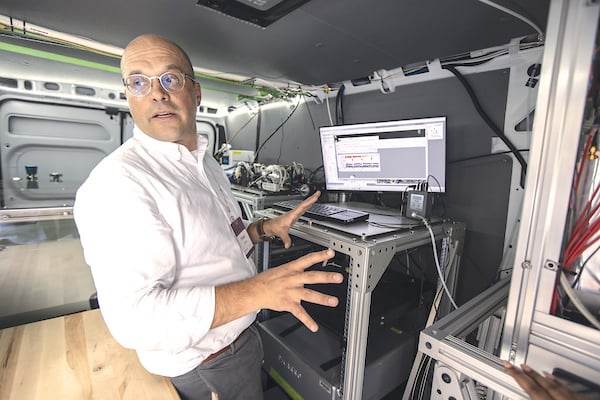
It’s All in the Plumbing
Earlier in the day, DeCarlo and Nault had rolled out of a leased garage space near the Johns Hopkins Homewood campus. DeCarlo drove. Nault, an assistant research scientist in the DeCarlo Lab and a research scientist with Aerodyne Research, gingerly threaded his legs around cables and a gimbal that supports a large computer monitor to take the middle spot on the bench seat. In his lap he set a wireless keyboard, where he sifted through several data displays and instrument readouts, making sure everything seemed to be online and working. His job today would be to monitor the instruments and take detailed notes as the researchers drove about the city and county. A second Ben, assistant research scientist Benjamin Werden, stayed behind in the garage to work on an instrument that they eventually will install in MOM+POP.
Bolted into the van behind DeCarlo and Nault is a set of racked instruments and power units. Behind the passenger seat, there’s an aerosol mass spectrometer. That one measures the size and chemical composition of particles in the air samples. There’s also
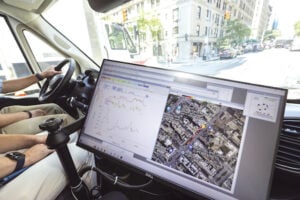
a proton transfer mass spectrometer, which monitors volatile organic compounds. It’s coupled to a gas chromatograph that performs additional analysis and toggles measurement back and forth between itself and the proton transfer mass spectrometer. To power all of this gear, there’s a portable generator and a rack of batteries. Everything produces heat, so there’s an additional air conditioner unit. Wires and cables snake everywhere, and there are a lot of tubes. (Plus DeCarlo’s travel mug, which bears a sticker that reads “Best Dad Ever”—he has two sons.) The air intake on the roof juts over the van’s nose, and the tubes route the air to the various instruments.
When asked about the multiple research disciplines his team applies to its fieldwork, DeCarlo first says, with a faint smile, “Plumbing. You think I’m joking, but I’m not. We draw air into instruments, and to do that, we need to put the tubes somewhere. Getting all that set up, splitting tubes from one instrument to another instrument, involves a lot of compression fittings and different materials, from copper to stainless steel to Teflon, and knowing how all those pieces fit together.” He advises prospective students that if they come to his lab for a PhD, they will do fun science plus become handier around the house.
The major instruments have to combine extraordinary sensitivity with sufficient ruggedness to be useable in the field. They are housed in racks equipped with shock absorbers, but DeCarlo slows the van to ease it over railroad tracks and patches of torn-up pavement. Out on the road gathering data or back in the garage, he and the Bens routinely have to be scientists one minute, engineers the next, computer techs after that, and sometimes guys with hand tools. They seem to enjoy the challenge of being researchers adept at fixing things on the fly. If a spectrometer acts up in the field, they can’t send it back to the vendor. Computer glitches need to be fixed in situ. And sometimes you just have to stop and blow into the GPS.
“It’s not a road trip,” DeCarlo says. “It’s not getting onto the interstate and putting it in cruise control and listening to some tunes. There are a couple of million dollars’ worth of instruments in the back of the van that you need to be concerned about.”
Northbound on Interstate 83, known locally as the Jones Falls Expressway, Nault points at the monitor where a graph showing nitrogen oxides spikes every time a truck rolls past. Out in the county on a two-lane road, they pass a BBQ joint, and DeCarlo says, “That smells good.” Atmospheric scientists supplement scientific instruments with their noses. DeCarlo cycles for fitness and often finds himself wondering what instruments might reveal about something he’s picked up with his onboard olfactory sensor.
Around the Oregon Ridge natural gas pipeline and pumping station, the van picks up no alarming readings on methane levels. The natural gas infrastructure in the U.S. is old and leaky, especially on the East Coast. DeCarlo recalls receiving a video from Ellis Robinson, a Whiting School research engineer. Robinson was doing a walking survey of a pipeline right of way in a county park outside of Pittsburgh when he came upon puddles bubbling with escaped natural gas. The pipeline beneath Oregon Ridge runs under a public park too, and one day DeCarlo was able to hike along a good bit of it wearing a sampling unit in a backpack. He detected two leaks. Data from that walk went into a paper that was under revision at press time. “Sometimes ’mobile’ means using your feet,” he says.
Sampling in ’Cancer Alley’
 Ethylene oxide (EtO) is a chemical that has its uses, especially as a disinfectant. For example, hospitals use it to sterilize things that can’t be run through an autoclave, like pacemakers. Plus, it is used to manufacture detergent, plastics, other chemicals, and solvents. But you do not want it in the air you breathe. EtO is mutagenic and carcinogenic. Online information from the Union of Concerned Scientists notes: “Chronic exposure to EtO through inhalation is associated with the development of cancers of the white blood cells, such as non-Hodgkin lymphoma, myeloma, and lymphocytic leukemia. Studies have also shown a relationship between EtO exposure and breast cancer in women. Also, because EtO is mutagenic—meaning it can change a cell’s DNA—children may be especially susceptible to its cancer-causing effects.”
Ethylene oxide (EtO) is a chemical that has its uses, especially as a disinfectant. For example, hospitals use it to sterilize things that can’t be run through an autoclave, like pacemakers. Plus, it is used to manufacture detergent, plastics, other chemicals, and solvents. But you do not want it in the air you breathe. EtO is mutagenic and carcinogenic. Online information from the Union of Concerned Scientists notes: “Chronic exposure to EtO through inhalation is associated with the development of cancers of the white blood cells, such as non-Hodgkin lymphoma, myeloma, and lymphocytic leukemia. Studies have also shown a relationship between EtO exposure and breast cancer in women. Also, because EtO is mutagenic—meaning it can change a cell’s DNA—children may be especially susceptible to its cancer-causing effects.”
Despite the recognized hazards, there has been little reliable monitoring of ambient atmospheric concentrations around the plants that produce or use EtO. The Environmental Protection Agency maintains some static air quality monitors, but for various reasons, they are not effective at measuring how much ethylene oxide is in the air at any given moment around or downwind of an emissions point source.
In February 2023, Bloomberg Philanthropies provided support for DeCarlo and other researchers to use an Aerodyne mobile lab and a second lab they put together themselves in a rented cargo van to sample the air in a section of southeast Louisiana that bears the unenviable nickname “Cancer Alley.” They were looking for EtO in particular, and they found it. That didn’t surprise them, but the quantities did.
By EPA standards, any EtO concentration of more than 11 parts per trillion constitutes a health hazard. The Johns Hopkins-led team found areas near chemical facilities that had concentrations of 40 parts per billion. That corresponds to exposure roughly 1,000 times higher than what is recommended, according to DeCarlo. Driving on surrounding roads, the researchers detected problematic EtO levels more than 10 kilometers downwind of the facilities.
Robinson, the study’s lead author, says, “We know very little about EtO concentrations in the atmosphere—the accumulated literature on ethylene oxide is so scarce, while the societal focus on ethylene oxide is so intense—and so any reports of accurate EtO concentrations are very valuable right now.” The study appeared on June 11 in the journal Environmental Science & Technology. The EPA recently tightened restrictions on EtO emissions from commercial sterilizing facilities and chemical facilities producing ethylene oxide.
Science with Social Purpose
When it came time to pick a field for graduate study, DeCarlo says, “I wanted to do something that involved chemistry and computation and data, and atmospheric science checked all those boxes.” That started him on more than 20 years of sampling air around the world.
In 2003, he collaborated with a mobile lab while doing preliminary work for his doctoral research, which resulted three years later in him on a flight over Mexico City gathering data. He had already, in 2003 or 2004 (he’s a bit fuzzy on the time), worked with grad school roommates to rig up their own van and drive it around Colorado. Postdoctoral work took him to Switzerland in 2008–10. Werden joined him in Nepal in 2015, working to better understand the sources of air pollution in the Kathmandu Valley. A major earthquake interrupted their work, which they resumed in late 2017 and early 2018, when they and Nepalese collaborators rented a van, took out several of its bench seats, filled it with instruments and 12 lead-acid batteries, and drove around for a month gathering data.
On the road in Baltimore County, we drive past McCormick & Company’s spice facility, and Nault points to a section of the monitor that shows a spike in terpenes. Terpenes in the air are not a health hazard—they are what make the air around McCormick smell good. They occur naturally in spices and herbs, and the spice company uses them for various products. Detect something citrusy in the air? That would be limonene. Enjoy a deep breath. It won’t hurt you.
As DeCarlo drives through a section of office parks, Nault says, “Random nitrogen oxide plume there.” DeCarlo glances out the 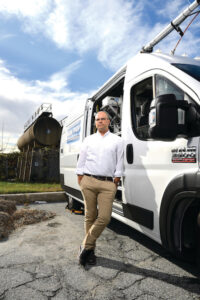 window: “Lawn care. Weed whacker.” There’s a landscape crew tending the grass beside the street. We pass a landfill, and he has a look at several visible vent pipes. “All of those are spinning, so something is coming out.” Behind a familiar yellow vehicle, he asks, “Is that a clean school bus or a dirty school bus?” Nault, who has been typing notes throughout the morning, reads aloud from the data display: “Twenty. Thirty. Forty. Okay, not clean.” A few minutes later, behind another public transport, Nault says, “Holy crap, 300 parts per million because of that bus!” He’s not specific about 300 parts per million of what, but it’s clearly nothing good.
window: “Lawn care. Weed whacker.” There’s a landscape crew tending the grass beside the street. We pass a landfill, and he has a look at several visible vent pipes. “All of those are spinning, so something is coming out.” Behind a familiar yellow vehicle, he asks, “Is that a clean school bus or a dirty school bus?” Nault, who has been typing notes throughout the morning, reads aloud from the data display: “Twenty. Thirty. Forty. Okay, not clean.” A few minutes later, behind another public transport, Nault says, “Holy crap, 300 parts per million because of that bus!” He’s not specific about 300 parts per million of what, but it’s clearly nothing good.
After about three hours, DeCarlo steers to a city recreation center, where a group of high school kids in a summer science program get a tour of the van and an explanation of the lab instruments. Then it’s back to base. Nearly home, DeCarlo looks at me and says, “So, would you want to do this six days a week for a month?” Days in the field are long, usually an hour or two of prep before moving out, then eight hours of gathering data, finished by a last hour or more checking out the instruments to make sure everything will be ready to go the next day.
Their curiosity as scientists meshes with a sense of social purpose. DeCarlo worked in the EPA’s Office of the Science Advisor as an American Association for the Advancement of Science and Technology and Policy fellow in Washington in 2010 and 2011.
He says: “Ultimately, we try to work in areas in which the science we do can inform not just the scientific community but also be used in discussions about policy. The work we do with MOM+POP is helping to inform questions about disparate exposures for people who live at the fence line of industrial facilities and where there are opportunities to improve the assessment tools that exist from regulatory agencies like the EPA.” He continues,
“I’ve always had this idea that we can use the instrumentation we have to answer important questions that are of importance not just to the scientific community but more broadly to society.”
The scientists also enjoy the detective work. Nault says that puzzling something out of a one-month dataset can take two years: “There are so many different things that can impact what we’re observing.”
DeCarlo adds, “You see something interesting, and you don’t know why. You’re out driving, and you see one chemical go up. Where were we when we took that reading? What was nearby? What could be causing it? You try to backtrack through the data and figure out what’s going on. It’s like searching for a needle in a haystack. But it’s a really cool needle.”




